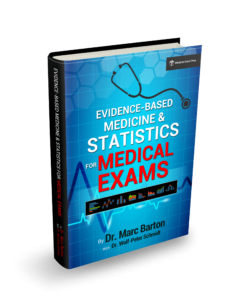Risk vs. odds
The terms ‘risk’ and ‘odds’ are often used interchangeably but they actually have quite different implications and are calculated in different ways.
Odds is a concept that is very familiar to gamblers. It is a ratio of probability that a particular event will occur and can be any number between zero and infinity. It is usually expressed as a ratio of two integers. For example an odds of 0.1 is written as 1:10 and an odds of 5 is written as 5:1.
Risk and risk ratios are more commonly used than odds and odds ratios in medicine as these are much more intuitive. Risk describes the probability of an event occurring. In medicine this is often an undesirable health outcome or adverse event. Risk is usually expressed as a number between zero and 1, although it can also be converted into a percentage. For example if there is 0.1 risk of developing a disease that means 1 in 10 people will develop the disease.
Odds and odds ratios rather than risk ratios are used in case-control studies because risks cannot be calculated. However, odds and odds ratios can also used to display the results of cross sectional studies, cohort studies and randomized controlled trials. The reason for this is that a commonly used regression model for binary (dichotomous) outcomes called logistic regression only allows the calculation of the odds ratio and not the risk ratio. Logistic regression models are fairly easy to do, and historically required little computing power. However, nowadays any smart phone has enough computing power to enable the use of regression models for binary data that can calculate the risk ratio (e.g. the log-binomial regression model).
Contingency tables
Contingency tables are a useful tool when attempting to calculate risk and make risk comparisons between different treatments being compared in a study.
Study results can be tabulated into a simple 2 x 2 contingency table as follows:
| DISEASE POSITIVE | DISEASE NEGATIVE | |
|---|---|---|
| EXPERIMENTAL GROUP | A | B |
| CONTROL GROUP | C | D |
This contingency table can then be used to calculate the control event rate (CER) and the experimental event rate (EER)
The EER is the event rate in the group given treatment with the experimental drug being investigated. This is also sometimes referred to as the absolute risk in the treatment group (ART).
The EER can be calculated from the above contingency table as follows:
EER = A / A + B
The CER is the event rate in the group given the control drug, which is sometimes a placebo. This is also sometimes referred to as the absolute risk in the control group (ARC).
The CER can be calculated from the above contingency table as follows:
CER = C / C + D
Relative risk
Relative risk (RR), which is also referred to as the risk ratio, is a ratio of the risk in each group. The relative risk is therefore a ratio of the EER and the CER:
RR = EER / CER
Absolute risk reduction
The absolute risk reduction (ARR) is the difference between the CER and the EER. The ARR can also be used to calculate the number needed to treat.
ARR = CER – EER
Relative risk reduction
The relative risk reduction (RRR) is the proportional reduction in the outcome rates between the experimental and control groups. It is calculated by dividing the ARR by the CER:
RRR = ARR / CER
The number needed to treat
The number needed to treat (NNT) is the average number of patients who need to be treated to prevent one additional adverse outcome. If a particular drug has a NNT of 5, it means that 5 people will have to be treated with this drug to prevent one additional adverse outcome. The ideal NNT is 1, where everyone that receives the treatment improves and no one improves with the control. The higher that the NNT is the less effective that the treatment is.
It is equal to the inverse of the ARR:
NNT = 1 / ARR
The number needed to harm
The number needed to harm (NNH) is calculated in the same way as the NNT but is used to describe adverse events. For NNH large values are considered favorable as this means that adverse events occur rarely. Conversely small values are considered to be unfavorable as this means that adverse events occur commonly.
Worked example
The best way to solidify an understanding of these concepts is to work through an example. Consider a study that has been performed to investigate a new treatment for preventing acute kidney injury in patients with diabetes mellitus.
A table showing the results of the study is shown below:
| Outcome: Developed acute kidney injury | Outcome: Normal renal function | Total patients | |
|---|---|---|---|
| Drug X | 100 | 900 | 1000 |
| Placebo | 200 | 800 | 1000 |
| Total patients | 300 | 1700 | 2000 |
In this study the CER can be calculated as follows:
CER = 200 / 1000
CER = 0.2
The EER can be calculated as follows:
EER = 100 / 1000
EER = 0.1
The RR can be calculated as follows:
RR = EER / CER
RR = 0.1 / 0.2
RR = 0.5
The ARR can be calculated as follows:
ARR = CER – EER
ARR = 0.2 – 0.1
ARR = 0.1
The RRR can be calculated as follows:
RRR = ARR / CER
RRR = 0.1 / 0.2
RRR = 0.5
The NNT can be calculated as follows:
NNT = 1 / ARR
NNT = 1 / 0.1
NNT = 10
Medical Exam Prep would like to thank Dr. Marc Barton for permission to reproduce this extract from his book ‘Evidence-Based Medicine & Statistics for Medical Exams’
About Dr. Marc Barton
Dr. Marc Barton qualified from Imperial College School of Medicine in 2001. Since that time he has worked in a variety of different medical specialities. He worked as a GP partner from 2006 until 2008 and more recently as a higher specialist trainee in Emergency Medicine.
‘Evidence-Based Medicine & Statistics for Medical Exams’ is available for purchase here.
Header image used on licence from Shutterstock






